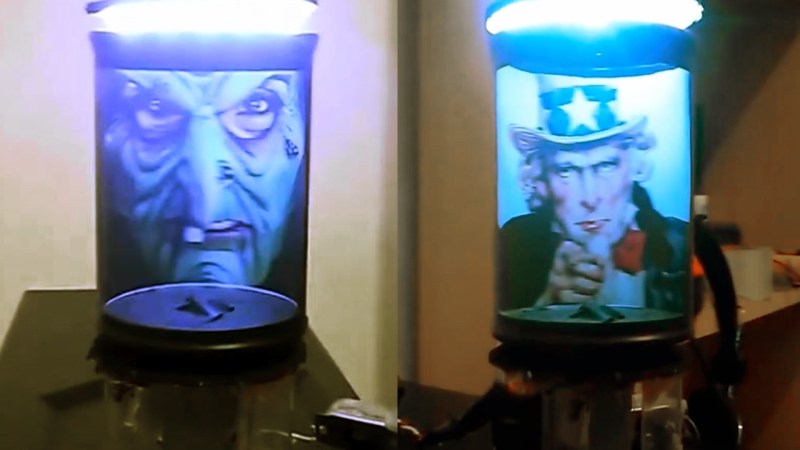Back in 2018, [Salah] created a prototype display that seems to defy logic using little more than a Pringles can and a fast motor. While not volumetric, this hack does show the same 2D image from any vantage point in 360 degrees around it.
How can cardboard create this effect? Somewhat like a zoetrope uses slits to create a shutter effect, this display uses a thin slit to limit the view of the image within to one narrow vertical slice at a time. When moving fast enough, Persistence of Vision kicks in to assemble these slices into a complete image. What we think is so cool about this hack is that the effect is the same from any angle and by multiple viewers simultaneously.
The project page and video demonstration after the break are light on details, though the idea is so simple as to not require additional explanation. We assume the bright LED seen in the video below was added to overcome the relatively dim appearance of the image when viewed through the narrow slit and isn’t strictly required.
If you are a fan of modern updates to victorian display technology, be sure to check out the 3D printed zeotropes and phenakistiscopes by [Akinori Goto], [Jeremy], and [Greg Borenstein] too.
















How, what a neat idea, though provoking too – hmm lottsa potential, I like it :-)
Thanks for posting, cool !
Second that. Highly creative.
bulding one for the next funeral i attend…
bwahahaha.
Sweet. Does anyone make a flexible OLED to use instead of the piece of paper?
adafruit sells one
https://www.youtube.com/watch?v=NURLeeyPu2c
Oh wow, that’s a nice display
Now to find a way to get a display into the tube so it can display a live image.
Maybe a mirrored surface around the cylinder and then a mirrored lens in the top might do the trick, then the display could be mounted at the bottom.
That’s a good idea. I think the display would have to spin with the tube, but that could be figured out.
Maybe one of those flexible OLED displays used in foldable phones could do?
Also if it can update fast enough, this could display a stereographic image. Though I think that would work only from one or several discrete angles.
Nah, just a flexible oled display and a slip ring for power/data.
Slip ring for power, radio or optical for data. slip ring for data is not much a good idea
Rotary transformer works well for data.
Old VHS players are great source for them, they are used to couple the ~5 MHz signal from the play heads.
Yep, like people below (above?) said, OLED curved screen, slip ring (rotary transformer) for power, data and the rest could be done in software. This would be cool for live/zoom meetings, everyone on zoom could be in a “tube” and everyone there live could see them face on, wherever they sat. Now which way to the patent office?
I had the same idea but … for what ? With a Flexible display you already have a 360 screen. Yes the face always looking at you, but I still don’t get a good use case
Reminds me of the “holograms” you’d see in earlier FPS games that used 2d sprites in a 3d world, it was done to work within hardware limitations in those games but this could actually be a very useful technology. You could even combine a display on the inside of the tube with a strip or two of LEDs on the outside so it could do double duty as a directional POV display.
I was thinking the same!
And imagine a dimly lit room with large pixelated Doom II textures on the walls, and then imps (monsters) roaming the room, where the imps are made from this technology. Except it’s a screen instead of a paper, and they rotate in distinct steps (Doom monsters had 56 images per sprite, or monster. Walking animation plus direction. They were all symmetrical so 8 combinations came for free.)
The monsters in Doom were not completetly static, but they rotated in distinct steps…
Now wake up some poor hungover person in that room, it would be like waking up inside Doom, complete with the abstract animations.
i played a source port of DOOM in VR and there was a very similar effect. i felt like i was in a shoebox diorama. the presence was real but the flat sprites and fuzzy walls made it a surreal experience.
See: Ketchpel, R.D. — Direct-view three-dimensional display tube – 1962. For a real 3D volumetric display. Note the year!
I can’t wait to see the thoughts and ideas mentioned above come to life… I suspect by next weekend knowing the brains in front of the screens around here.
I loved this idea so much that I made my own version of it: https://antibore.wordpress.com/2022/10/12/persistence-of-vision-device/